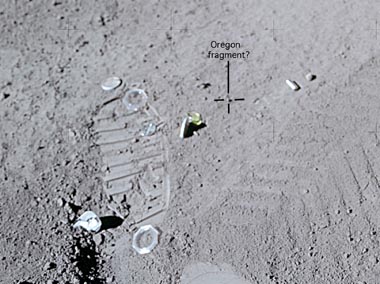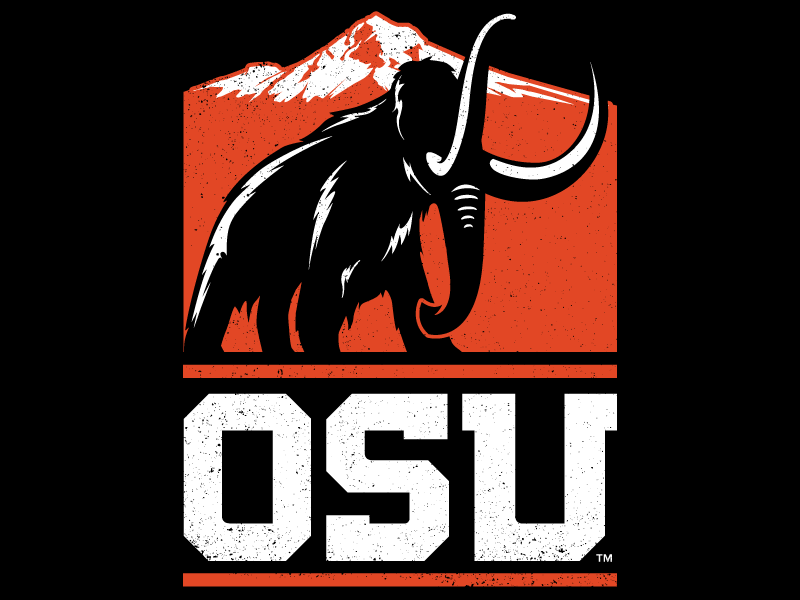Speaking of sneaking things on a lunar mission, there is a piece of Central Oregon lava on the moon. Initially the astronauts would come to Lava Lands to work not knowing what the service would be like. Long story short, an ODOT worker proposed an astronaut take a piece of lava to the moon. He did. Dropped it there. Centuries from now, some geologist is going to find it and wonder where in the hell this came from.
Some great stuff here inspires me to continue on with the Apollo missions.
Originally, only the manned Apollo missions were supposed to be numbered. However, there was a fire in a test 25 days before Apollo 1 was set to blast off. NASA had determined that the next mission would be called Apollo 1, but the widows asked that Apollo 1 be applied to their deceased husbands' test and that the number be retired. Apollo 1 was actually the fourth Apollo Saturn IB mission, but the first three were unmanned. Because there had already been three Apollo Missions, those three were collectively numbered 2 and 3. Apollo missions 4-6 were also unmanned. 5 tested the lunar module with an empty Saturn IB set-up (because NASA had one leftover). Apollos 4 and 6 tested the new, upgraded Saturn V system.
The Apollo missions were set up so that the back-up crew to a mission was supposed to rotate in to the third mission following.
Apollo 7 Prime Crew:
Wally Shirra
Donn Eisele
Walter Cunningham
Backup Crew:
Thomas Stafford
John Young
Gene Cernan
The Apollo 7 Prime Crew was the Apollo 1 Backup Crew. The Apollo 7 Backup Crew became the Apollo 10 Prime Crew. Shirra announced his retirement from NASA shortly before the Apollo 7 launch. Shirra became the first person to fly in space three times. Cunningham took over the Skylab Program after Apollo 7.
The original Apollo 8 Prime Crew consisted of:
James McDivitt
David Scott
Rusty Schweickart
The original Apollo 8 Backup Crew consisted of:
Pete Conrad
Richard Gordon
Alan Bean
The Apollo 8 Backup Crew was set to become the Prime Crew of Apollo 11. However, fate intervened. The lunar module was upgraded after the Apollo 5 test but was not yet ready. The mission plan for Apollo 8 specifically required them to have a fully-operational lunar module. The upgraded CM, though, was set to be ready three months before the upgraded LM. Thus, it was decided to swap Apollo 8 and 9.
Apollo 9's (what became Apollo 8) original Prime Crew consisted of:
Frank Borman
Michael Collins
William Anders
The Backup Crew:
Neil Armstrong
Jim Lovell
Buzz Aldrin
Michael Collins was found to have a cervical disc herniation, which required two vertebrae to be fused together, so he was removed and replaced with his backup, Lovell. Aldrin took over Lovell's place. Fred Haise took over Aldrin's vacated spot.
As previously stated, 8 and 9 switched places.
The Prime Crew on 10 was the Backup Crew on 7. Only Eisele returned as a Backup on 10. Gordon Cooper replaced Shirra and Edgar Mitchell replaced Cunningham. Eisele retired after serving as Backup on 10.
Collins recovered in time to be the Command Module Pilot on 11. Deke Slayton gave Armstrong the option of replacing Aldrin by Lovell, because Aldrin was not as well liked by everyone at NASA as Lovell. Armstrong, however, thought that Lovell should command his own mission, so Aldrin was the second man to walk on the Moon. Borman was assigned to serve as NASA's presidential liaison to (unofficially) try and make sure that Nixon did not compromise the mission. Lovell took over Borman's spot, Anders took over Lovell's spot, and Haise took over Anders' spot. Anders retired from NASA shortly thereafter. Ken Mattingly, who had been CAPCOM on Apollo 8 and had been Anders' backup on 11, replaced him.
The original Backup Crew of 8, which became 9, became the Prime Crew on 12. The Commander of 9, McDivitt became the Manager of the Apollo Spacecraft Program and was the Program Manager for Apollo missions 12-16. Schweickart was sick on 9. He grew even sicker after leaving the module on a five-minute spacewalk. He was still being tested after 9, when training for 12 started. Scott thus took over command of the 12 Backup Crew. McDivitt and Schweickart were replaced by Alfred Worden and James Irwin respectively. All three were from the Air Force and constantly pranked the three Naval members of the Apollo 12 Prime Crew. The three would comprise the Prime Crew on Apollo 15.
Alan Shepherd had been grounded by Meniere's Disease since 1964. Shepherd discovered that a cure to his specific type of Meniere's Disease had been discovered in 1968. A successful surgery was performed in early 1969, and he was cleared to fly in May 1969. Shepherd asked to be given command of an Apollo mission. Shepherd was generally beloved and immediately was slated to replace Gordon (who was much less well-liked) on Apollo 13. The problem then became replacing Eisele, who had retired after Apollo 10. Shepherd asked McDivitt, who was in charge of the Apollo Program and was slated to be Program Manager to fly one more mission with him. McDivitt did not believe that Shepherd had sufficient experience to Command an Apollo mission, so he balked. This led to Stu Roosa taking over the third spot on the mission. Because none of the three had ever flown on a real Apollo mission, George Mueller refused to allow the three to go up in Apollo 13.
Instead, the Prime Crew for Apollo 13 was slated to be Lovell, Mattingly, and Haise. As the Commander of Apollo 10, Thomas Stafford was slated to be Commander of the Backup Crew, but he was tapped to replace Alan Shepherd as second-in-command to Slayton. John Young took over his position. Cernan had the option to serve as part of the Backup Crew on 13 but declined to command the Backup Crew on 14. Jack Swigert assumed Young's position. (By that time, the CM Pilot position was out-of-favor as that individual did not get to walk on the Moon. Swigert actually was primarily promoted tot he position, specifically because he agreed that he would not walk on the Moon.) Charles Duke was CAPCOM on Apollo 10 and 11. It is his voice that said, "Roger.....Tranquility, we copy you on the ground." Duke took over Cernan's vacated position. One week before Apollo 13 was scheduled to blast off, Duke came down with rubella and exposed the Prime and Backup Crews. The only member of the Prime Crew to have never had rubella was Mattingly. Mattingly was thus replaced with Swigert. NASA counted Duke and Mattingly's time as time on the Backup Crew. Thus, Young, Mattingly, and Duke would serve as the three astronauts on Apollo 16.
Apollo 14 was supposed to launch on October 1, 1970 but was delayed four months to implement improvements necessitated by the Apollo 13 near-disaster. Apollo 14 flew with Shepherd, Roosa, and Mitchell. Armstrong, Collins, and Aldrin did not return as part of the Backup Crew. Cernan took over as Commander of the Apollo 14 Backup Crew with Ronald Evans as CM Pilot and Joe Engle as LM Pilot. Apollo Mission 12-17 were designed to focus more on geology. Because of backlash from the scientific community that pilots were being taught geology, Harrison Schmitt was part of the Backup Crew on Apollo 15, a geologist trained to be an Apollo pilot. Schmitt was scheduled to be on Apollo 18 but, after that was cut, he replaced Engle on Apollo 17.
The Prime Crew on Apollo 15 was the same Air Force screwballs that had pranked the Navy screwballs on Apollo 12. The important one was Irwin, who trained in the lava fields of Oregon. After he was done training, Floyd Watson sent a small chunk of lava rock from Devil's Lake near Bend to Irwin and asked that Irwin place it on the Moon. Irwin did so, photographed it, and autographed it. A copy of the photograph made the front page of the Bend Bulletin on October 2, 1971:

Eric M. Jones, the editor of the Apollo Lunar Surface Journal, identified the fragment below as the Oregon lava rock.

The rock can also be seen in this more iconic picture:

Although, I have no idea where. After cancellation of Apollo 19, Apollo 15 was set to be the Backup Crew on 17. However, the three had taken approximately 400 unauthorized stamps into space and had sold about 100 for approximately $21,000.00. (The three were each making about $24,596.00 per year as astronauts, so the money would have been the equivalent of about 3-4 months' worth of wages.) None of the three Apollo 15 astronauts ever flew in space again.
The Backup Crew of Apollo 15 was commanded by Gordon, who had flown the CM around the Moon on Apollo 12. Schmitt was the LM Pilot. Vance D. Brand was set to replace Gordon as the CM Pilot. Gordon and Brand were set to fly on Apollo 18, but it was cancelled. As a result, Schmitt replaced Engle.
Apollo 16 was crewed by Young, Mattingly, and Duke. The Backup Crew on 16 was commanded by Haise. William Pogue and Gerald Carr were set to be part of the Backup Crew. However, after Apollo 19 was cancelled, the two spots were taken over by Mitchell and Roosa. Pogue and Carr were reassigned to the Skylab program, flying on Skylab 4.
Apollo 17 was crewed by Cernan, Evans, and Schmitt. Young and Duke from the Apollo 16 Prime Crew and Roosa from the Apollo 14 Prime Crew comprised the Backup Crew. Shortly before reentering the LM, Cernan said:
I'm on the surface; and, as I take man's last step from the surface, back home for some time to come - but we believe not too long into the future - I'd like to just [say] what I believe history will record. That America's challenge of today has forged man's destiny of tomorrow. And, as we leave the Moon at Taurus-Littrow, we leave as we came and, God willing, as we shall return, with peace and hope for all mankind. Godspeed the crew of Apollo 17.
Cernan then became the last man to walk on the Moon. He re-entered the LM behind Schmitt and blasted off from the lunar surface on December 14, 1972. The three astronauts splashed down in the Pacific Ocean five days later. In all, it had been 39 days short of six years since the fire on Apollo 1.






